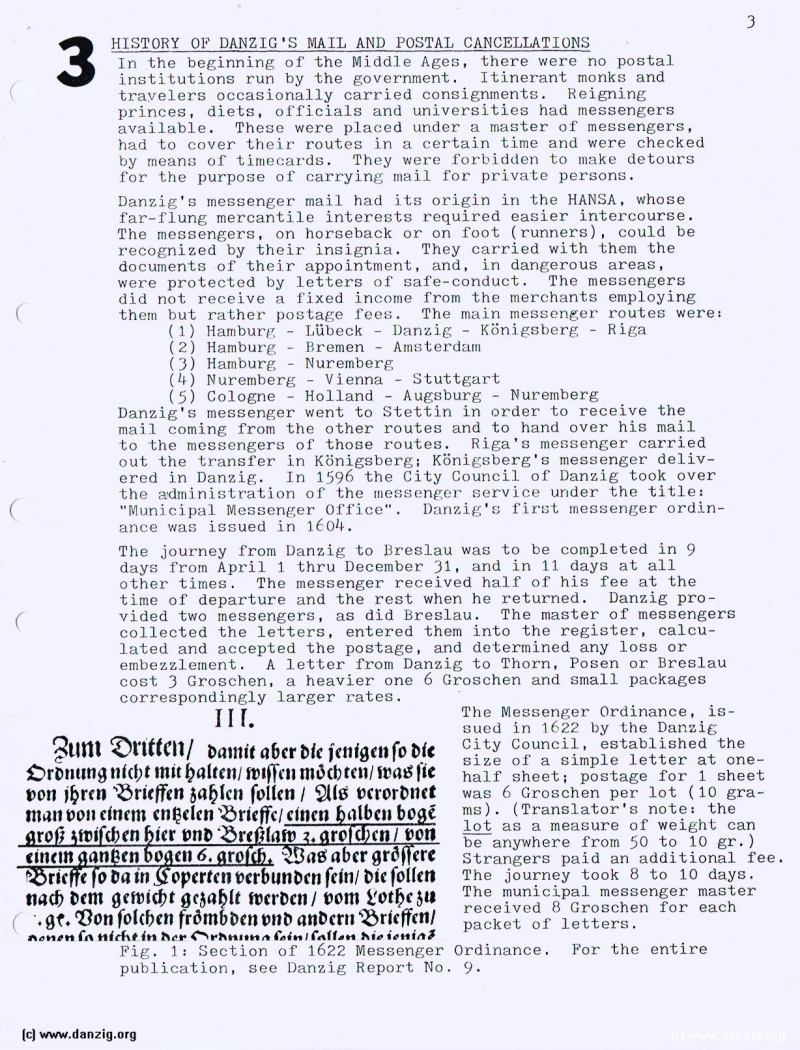
HISTORY OF DANZIG’S MAIL AND POSTAL CANCELLATIONS
In the beginning of the Middle Ages, there were no postal institutions run by the government. Itinerant monks and travelers occasionally carried consignments. Reigning princes, diets, officials and universities had messengers available. These were placed under a master of messengers, had to cover their routes in a certain time and were checked by means of timecards. They were forbidden to make detours for the purpose of carrying mail for private persons.
Danzig’s messenger mail had its origin in the HANSA, whose far-flung mercantile interests required easier intercourse. The messengers, on horseback or on foot (runners), could be recognized by their insignia. They carried with them the documents of their appointment, and, in dangerous areas, were protected by letters of safe-conduct. The messengers did not receive a fixed income from the merchants employing them but rather postage fees. The main messenger routes were:
(1) Hamburg - Lübeck - Danzig - Königsberg - Riga
(2) Hamburg - Bremen - Amsterdam
(3) Hamburg - Nuremberg
(4) Nuremberg - Vienna - Stuttgart
(5) Cologne - Holland - Augsburg - Nuremberg
Danzig’s messenger went to Stettin in order to receive the mail coming from the other routes and to hand over his mail to the messengers of those routes. Riga’s messenger carried out the transfer in Königsberg; Königsberg’s messenger delivered in Danzig. In 1596 the City Council of Danzig took over the administration of the messenger service under the title: “Municipal Messenger Office”. Danzig’s first messenger ordinance was issued in 1604.
The journey from Danzig to Breslau was to be completed in 9 days from April 1 thru December 31, and in 11 days at all other times. The messenger received half of his fee at the time of departure and the rest when he returned. Danzig provided two messengers, as did Breslau. The master of messengers collected the letters, entered them into the register, calculated and accepted the postage, and determined any loss or embezzlement. A letter from Danzig to Thorn, Posen or Breslau cost 3 Groschen, a heavier one 6 Groschen and small packages correspondingly larger rates.
The Messenger Ordinance, issued in 1622 by the Danzig City Council, established size of a simple letter at one half sheet; postage for 1 sheet was 6 Groschen per lot (10 grams (Translators note: the lot as a measure of weight can be anywhere from 50 to 10 gr.) Strangers paid an additional fee. The journey took 8 to 10 days. The municipal messenger master received 8 Groschen for each packet of letters.
Figure 1: Section of 1622 Messenger Ordinance. For the entire publication, see Danzig Report No. 9.
Danzig Report Nr. 12 – November - December - 1976, Page 5.
Hits: 1644
Added: 31/05/2015
Copyright: 2024 Danzig.org

